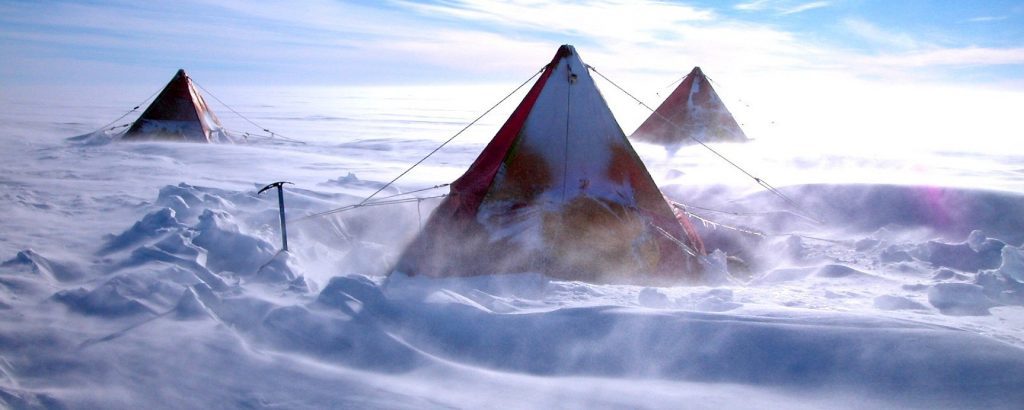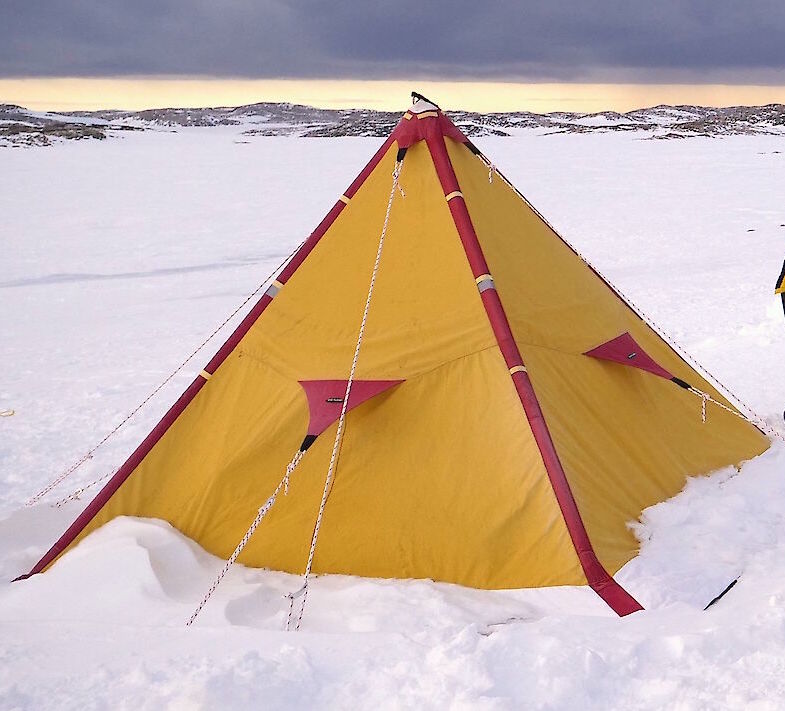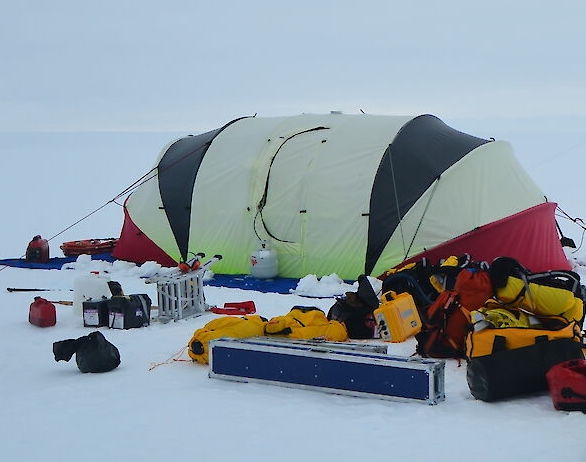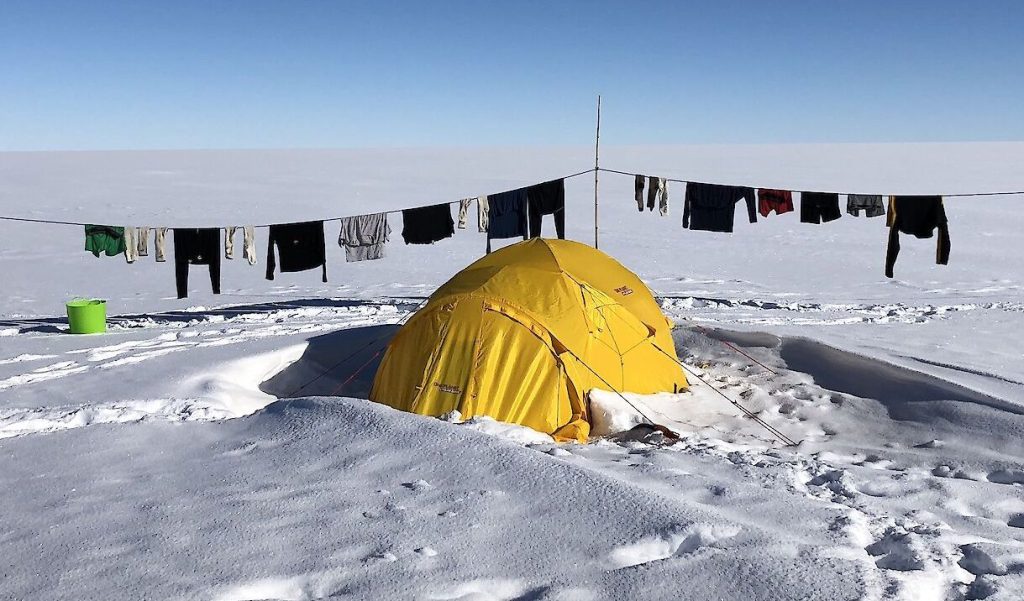What tents are used in Antarctica and equally what tents are used by polar explorers has been an often-asked question when understanding the extreme conditions that tents can endure.


In this article we’ll take a look at:
What tents and shelters are used by polar explorers in Antarctica.
How extreme is the weather in Antarctica and can you survive in a tent there.
How much do Antarctic tents cost and how do they differ to ‘everyday’ tents.
Types Of Shelter Used By Polar Explorers In Antarctica
Starting with what shelters are used at base camps in Antarctica, these tents are not the sort of tents you would carry with you on your back.
They use heavyweight materials to withstand harsh Antarctic winds for prolonged periods.
They are transported using planes and sleds before being used to set up a permanent base camp.
Scott’s Polar Tents or Polar Pyramid Tents


These tents are based on the original tents used by Captain Scott, a famous British Antarctic explorer.
Today’s versions of these tents have been enhanced using modern day materials but the shape and idea has remained much the same as the original.
The design of the tent means that when erecting it, it is best to angle it so that the wind doesn’t hit just one face of it directly or square on.
The entrance should also always be downwind to ensure snowdrift doesn’t cover it.
Using ice axes, shovels, skis or poles in place of pegs can allow these tents to withstand winds of up to 100 km/h.
Endurance Tents


Another tent used as a more permanent base camp option is the Endurance Tent.
They usually come in 2 sizes, 16 feet long and 21 feet long and will sleep up to 12 people.
Often used to store equipment or as the kitchen, they can be opened up at one end, making it easier to move things in and out.
Dome Tents


Lighter weight dome tents are not used as a permanent shelter in Antarctica, rather a temporary solution if weight is a concern on an expedition or field trip, or as an emergency shelter.
Due to the strength of the wind in Antarctica it is recommended to contsruct a snow wall around a lighter dome tent to offer added protection.
Other Shelters Used In Antarctica


There are a range of more permanent, ‘solid’ shelters used in the Antarctic.
These include Apple and Googie huts, Tank huts, Aanbus shelters and Traverse Vans and Caravans.
These are definitely not tents and more of a secure, permanent structure often used for prolonged periods of staying in the Antarctic.
How Extreme Are The Conditions In The Antarctic?
With an average monthly temperature, in the ‘summer months’ of -28°C and average lows in the winter of -60°C, you could say that the Antarctic is on the cold side.
Antarctica is also considered the windiest place on earth with winds often getting above 100 km/h in the winter months.
It is fair to say that if your tent can work here, it will do the same in any other part of the world.
Can You Survive In a Tent In Antarctica?
The simple answer is yes.
Polar expeditions are continuously taking place in Antarctica for various pieces of scientific research.
These expeditions can last months and even years at a time.
Granted, where possible, people will stay in the more permanent styles of shelters but they will also spend considerable time sleeping and surviving in a tent whilst on field operations.
Obviously the tent is only part of the key to surviving in the Antarctic.
Specialist clothes and ultrawarm sleeping bags are imperative for Antarctic survival whilst sleeping in a tent.
How Much Do Tents Suitable For The Antarctic Actually Cost?
Hilleberg (https://hilleberg.com/eng/) have been making tents for over 50 years and their tents are widely considered the benchmark when it comes to tents suitable for Antarctic travel.
They have an extensive range but the Hilleberg Keron 3 has been used on multiple Antarctic expeditions.
Cost at the time of writing is in the region of $1195.


Jack Wolfskin (https://us.jackwolfskin.com/) developed the Antarctica Dome tent with polar explorer Arved Fuchs so you know this tent is capable for Antarctic travel.
Cost at the time of writing is in the region of $1299.


One Planet (https://oneplanet.au) Polar Pyramid’s design is based on Scott’s polar tents and first produced in 2003 especially for the Australian Antarctic Division.
It has a tunnel door entry and can actually accommodate solar panels and antennae.
Prices only available on request!


How Do Antarctic Tents Differ To ‘Everyday’ Tents?
In order to answer this it is best to divide the tents into two categories.
Firstly you have the tents that will be used for the base camp.
These tents differ significantly to ‘everyday tents’ in that they can not be carried in a rucksack due to their size and weight.
As mentioned earlier these are set up as a more permanent shelter.
One Planet’s Polar Pyramid when folded up is still 170cm x 35cm x 35cm and weighs 30kg so definitely not one to be carried in a rucksack on your back.
Secondly you have the tents that you can carry in a rucksack but most of the time, if moving on foot or skis, would be towed on a sled.
The Hilleberg Keron 3 and Jack Wolfskin Antartica Dome have a packed weight of 4.2kg and 5.6kg respectively, making them both a viable option for an everyday backpacking tent.
For the price, you are firstly getting the research and development that has gone into the tent and secondly, premium materials used for construction.
This results in tents that can withstand the harshest of conditions, in the harshest of environments.
